Hold the salt: Tommy Greenwell prefers pepper
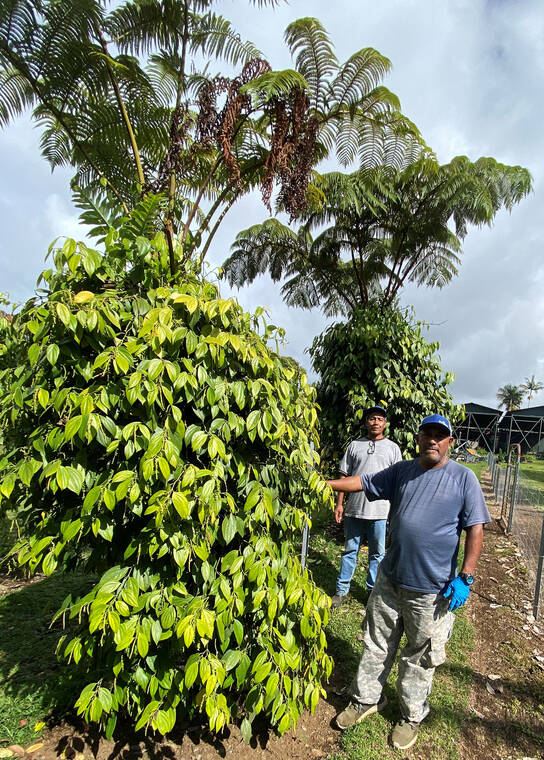
Linus Amor and Bernard Dores showed Tommy how to grow black pepper on hapu’u fern. (Gwen Scott via Diana Duff/Special to West Hawaii Today)
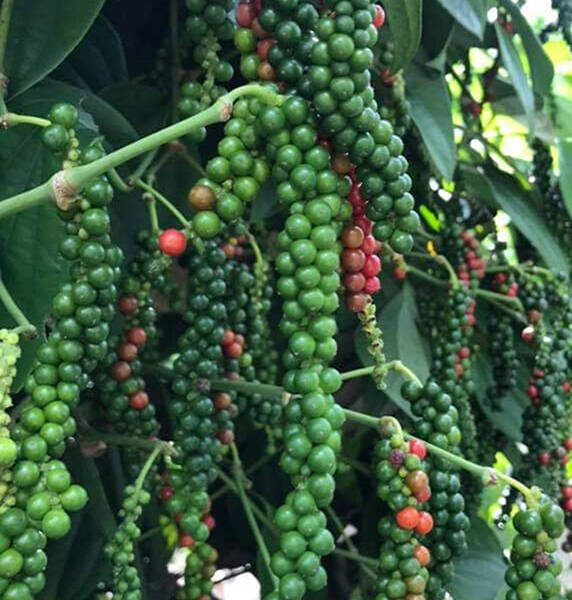
Mature pepper plants will produce multiple racemes full of pepper drupes. (tottamfarmfresh.com via Diana Duff/Special to West Hawaii Today)
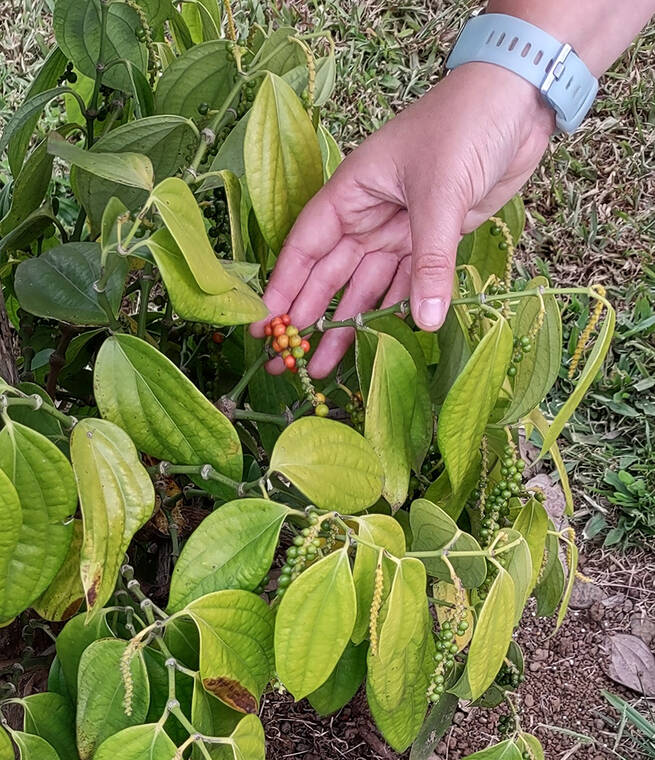
The pepper drupes that turn red are processed as white pepper. (Diana Duff/Special to West Hawaii Today)
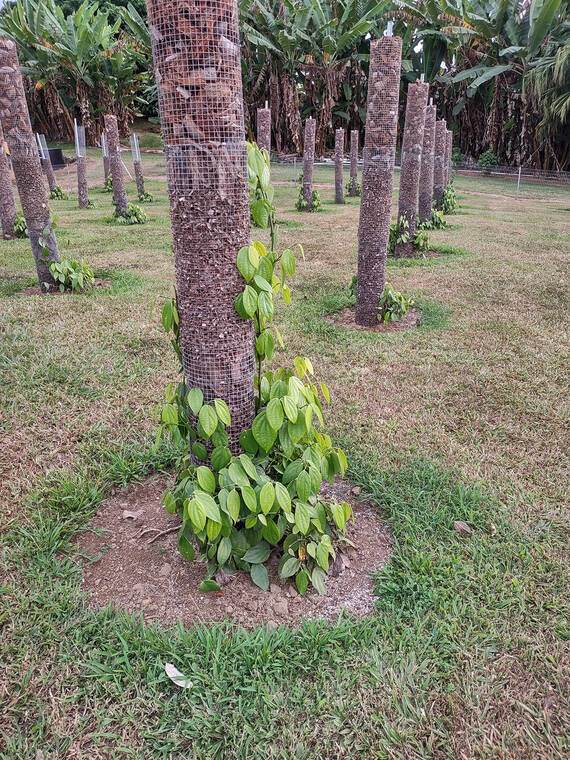
The younger black pepper plants at Greenwell Farm are being grown on cages filled with coco husks. (Diana Duff/Special to West Hawaii Today)
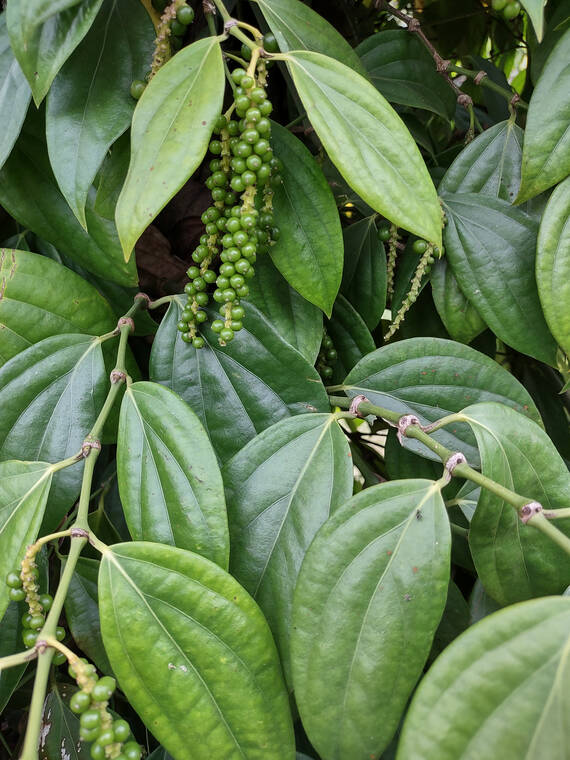
Numerous green peppercorns appear along a raceme once the flowers have been pollinated. (Diana Duff/Special to West Hawaii Today)
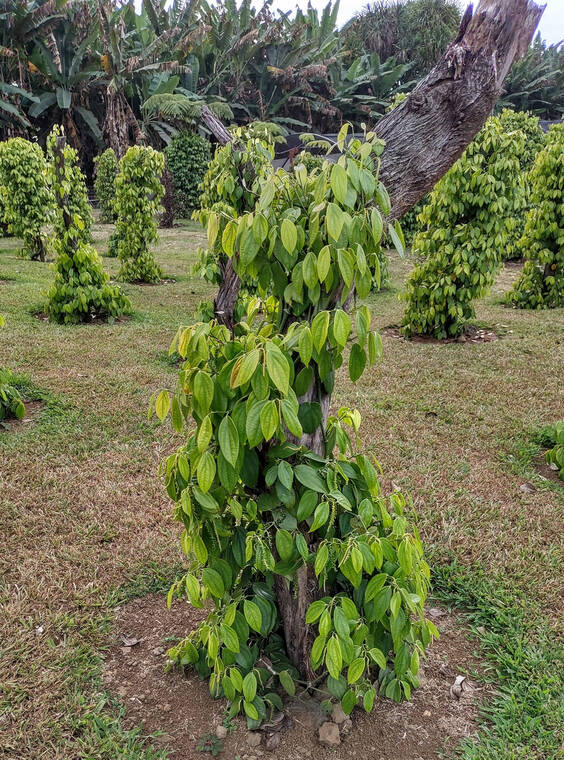
Kiawe posts support many of the older black pepper plants at Greenwell Farm. (Diana Duff/Special to West Hawaii Today)
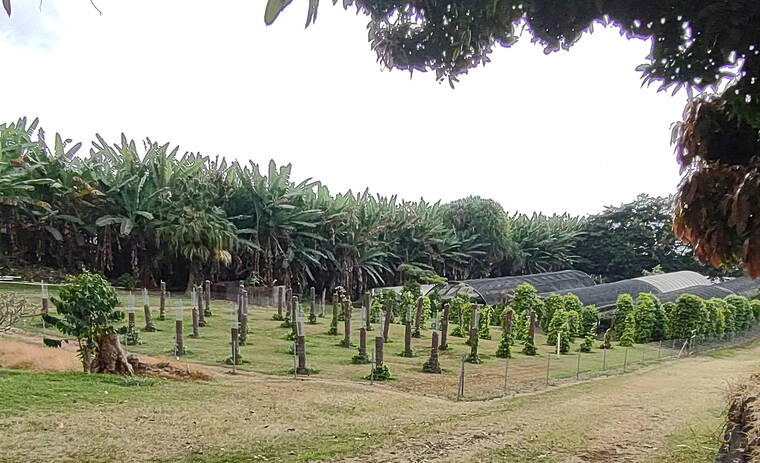
Most of the black pepper plants on Greenwell Farm grow in a fenced off area below the coffee processing facility. (Diana Duff/Special to West Hawaii Today)
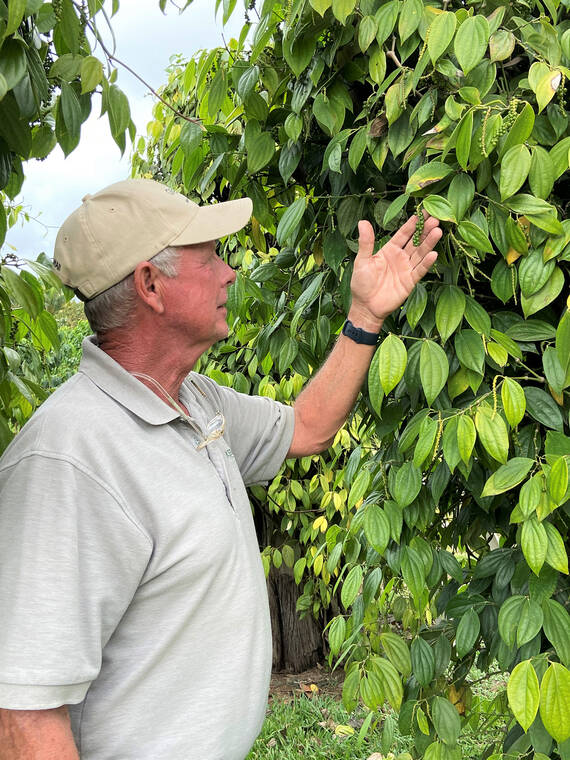
Tommy makes frequent visits to the black pepper plants to check for ripeness. (Gwen Scott via Diana Duff/Special to West Hawaii Today)
In a recent Hana Hou magazine article, I read about coffee farmer Tommy Greenwell’s decade-long venture into growing black pepper on his farm in Kealakekua. Being a fan of fresh-ground black pepper, I wanted to try some of his. No luck. He’s sold out for the season. I did, however, take one of his farm tours and had a chance to see his field of pepper vines, standing tall in the late afternoon sun.
In a recent Hana Hou magazine article, I read about coffee farmer Tommy Greenwell’s decade-long venture into growing black pepper on his farm in Kealakekua. Being a fan of fresh-ground black pepper, I wanted to try some of his. No luck. He’s sold out for the season. I did, however, take one of his farm tours and had a chance to see his field of pepper vines, standing tall in the late afternoon sun.
Pepper grows well on Greenwell’s South Kona farm. His plants are thriving in full sun with some afternoon cloud cover and regular rain.
“These last three years of rain in Kona did in some of my pepper plants. When the soil got saturated, they just gave up the ghost,” Tommy lamented.
Today, he has nearly 100 highly productive pepper vines growing on his farm. Though he continues to plant more plants every year, he finds it hard to keep up with the growing demand for Kona-grown black peppercorns.
The history of the Greenwell family in Kona goes back four generations to Tommy’s great grandfather who came from England to buy land in Hawaii. When he realized that coffee plants grew well on his mauka ranch in South Kona, he decided to become the first unofficial US coffee ambassador.
In 1873, Henry Nicolas Greenwell took some Kona grown coffee to the World’s Fair in Vienna, Austria, and came away with an award of excellence. He continued promoting Kona coffee at the Philadelphia World’s Fair three years later and spent most of his life travelling in pursuit of information on growing coffee and citrus while continuing to promote his Kona-grown coffee.
In early 1900, Henry’s wife (Tommy’s great-grandmother) set about planting coffee plants on what had been a cattle ranch. Eventually, she found people who wanted to help farm the land and the crops thrived.
As time went on Tommy’s dad, Norman Greenwell, acquired some of the original land in the ahupua’a Kalukalu, just north of Captain Cook which today is considered part of Kealakekua. By 1985, Norman decided to maintain the property as a commercial coffee farm. Today, the land is home to the Kona Historical Society as well as the Greenwell Farm.
When Norman died in 1992, he left his 35-acre farm to his wife. When Tommy took on job of running the farm, most of the coffee was being sold to Japan. In 1998, Tommy’s mom, Jean, decided to hire her son-in-law, Steve Hicks, as chief financial officer and marketing manager. This helped them diversify their market to include the U.S. mainland as well as other countries around the world.
After a happenstance appearance of a curious tourist a few years later, Tommy gave his first tour. The experience demonstrated the value of introducing the public to the process of preparing a crop for market. He decided to learn more about ag tourism by visiting tours offered by Napa Valley wineries. He returned dedicated to educating the public about his crops and began offering farm tours nearly 30 years ago to great success.
Wise to the problems of mono-cropping, Tommy declares, “Don’t put all your eggs in one basket.”
He proceeded to diversify his farm by cultivating other tropical crops including citrus, high quality avocados and apple bananas. He also began experimenting with more unique crops like vanilla, cacao and black pepper.
When I asked if any of these other crops might eventually eclipse his coffee sales, he replied, “We’ll see how well we can control this rust disease, before moving on.”
Though other farmers in Hawaii are also growing vanilla and cacao commercially, Tommy is the only one growing black pepper on a commercial scale. He now has over a hundred plants producing about pounds of peppercorns annually.
It all began in the mid-1990s, when some of his Micronesian farm workers came back from a vacation to their family homes in Pohnpei. They brought peppercorns grown in Pohnpei and Tommy instantly fell in love with the bold, rich flavor of the corns. On their next trip the workers legally imported some pepper plant starts and Tommy began growing his own pepper.
Though most of the pepper he grows is picked when fully mature but still green, he lets some grow until they turn red. He often uses the fresh green corns in a secret recipe to make a paste for meat. He puts them in his juicer with mustard, Worcestershire sauce and ketchup to produce a flavorful paste that is great on steak.
Most of his pepper crop is processed, however, to become dry black peppercorns. After harvesting the raceme of green berries from the vine, the berries are separated and put in boiling water for a few minutes. This step in the process kills the embryo in the corns and stops further development. The corns turn black as they dry to a moisture level suitable for long term storage.
Tommy reports that they can harvest the black pepper plants three or four times a year. As he continues to add plants, his harvest does increase beyond the nearly one hundred pounds of finished peppercorns packaged in 2021.
The corns that turn red on the vine are subjected to the same boiling process which enables the red skin to be easily removed revealing a white seed. When dried, this seed becomes a milder white peppercorn.
Originally, Tommy grew his plants on hapu’u ferns like they do in Pohnpei. The root competition and shade that the hapu’u created led him to try growing on upright kiawe logs. Though that worked well, he is now experimenting with tall thin cages filled with coco husks for the pepper plants to grow on. They need a wide upright to grow well.
Currently, all of his pepper plant starts are going into the ground on his farm, but he did give some advice to folks who want to try growing black pepper themselves. The vines prefer full sun for most of the day and do well with regular, but not excessive rainfall. Soil that has some organic matter and drains well offers the best ‘terroir’ for black pepper. The vines definitely need some kind of wide support but require little care beyond that.
Tommy does prune side shoots every few months to keep plants between 3 and 4 feet wide. He also fertilizes three for four times a year with a balanced fertilizer and rarely finds the need to treat for insect or disease problems.
When I asked if pepper might grow well in pots, he recommended against that. Black pepper vines evidently have vigorous roots that are not pot friendly.
Black pepper plants grown from cuttings may need at least two years of growth before producing a peppercorn crop. Plants propagated from seeds can take up to five years to produce corns. Once processed, the black peppercorns can be stored in cool, dry locations for many years. Tommy reports he has some on hand that has been stored for over ten years that still retain the bold flavor of even later harvests.
When I asked what initially captivated his taste for the Pohnpei black pepper, he described the flavor as potent, spicy, warm and sweet with citrusy notes. Spoken like a true taste-testing farmer. As a lover of interesting flavors, I’m looking forward to tasting Tommy’s next harvest of black peppercorns.
Watch his website (greenwellfarms.com) for the appearance of four-ounce bags of black peppercorn on his specialty food and beverage list, but purchase quickly, this popular crop sells out fast.
Diana Duff is a plant adviser, educator and consultan1t living part time in Kailua-Kona.
Gardening Events
Gardening Events
Every Saturday: “Work Day at Amy Greenwell Garden” from 9 a.m. to 12:30 p.m. Meet at the Garden Visitor Center across from the Manago Hotel in Captain Cook. Come with a mask and be prepared to practice social distancing. Volunteers can help with garden maintenance and are invited to bring a brown baglunch. Water and snacks provided. Call Peter at (808) 323-3318 for more information.
Farmer Direct Markets
Wednesday: “Ho‘oulu Farmers Market” at Sheraton Kona Resort and Spa at Keauhou Bay
Saturday: “Keauhou Farmers Market” 8 a.m. to noon at Keauhou Shopping Center. Information on their online market: keauhoufarmersmarket.com/onlinemarket
“Kamuela Farmer’s Market” 7:30 a.m. to noon at Pukalani Stables
“Waimea Town Market” 7:30 a.m. to noon at the Parker School in Waimea
“Waimea Homestead Farmers Market” from 7:30 a.m. to noon at the Waimea middle and elementary school playground
Sunday: “Pure Kona Green Market” 9 a.m. to 2 p.m. at Amy Greenwell Garden in Captain Cook
“Hamakua Harvest” 9 a.m. to 2 p.m. at Highway 19 and Mamane Street in Honoka’a
Plant Advice Lines
Anytime: konamg@ctahr.hawaii.edu; Tuesdays and Thursdays from 9 a.m. to noon at UH-CES in Kainaliu at (808) 322-4893.


